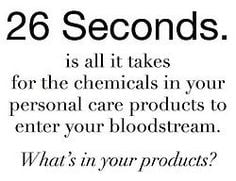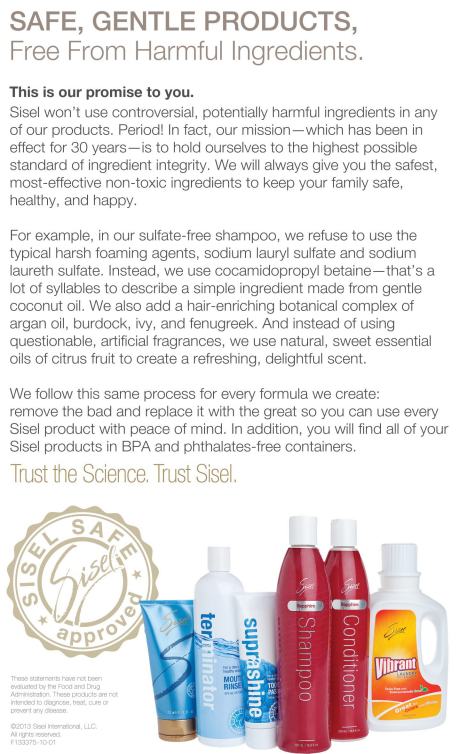Harmful ingredients in personal care products
Here is a helpful “watch list” of potentially harmful ingredients that may be contained in common personal care and cosmetics products you use every day
Sisel Safe® Challenge—See What’s in Your House
The Sisel Safe seal represents our commitment to develop and manufacture only the most powerful, safe, and effective products which are free of potentially harmful ingredients. At Sisel, we take your health seriously. If you check the products in your bathroom including your makeup you may find many of the following ingredients.
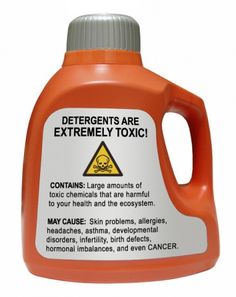
Potentially Harmful Ingredients
Alpha-Hydroxy Acids or Exfoliating Agents
- Used in cosmetics, skin creams, and facial peels
- Frequently cause redness, peeling, and irritation of the skin
Aluminum
- Used in antiperspirants and cosmetics
- Research suggests a possible link between aluminum and disorders of the central nervous system, such as Alzheimer’s disease
Benzophenones
- Used in all types of personal care products to protect fragrances from being damaged by UV light. Also used in some sunscreens.
- Are derivatives of highly toxic benzene, and are known as skin, eye, and respiratory irritants.
Bisphenol A
- Used as a coating or ingredient for bottles, plastics, and food containers.
- Research suggests a possible link between bisphenol A and increased risk of diabetes and heart disease. It is also an endocrine disruptor and has been shown to have negative prenatal effects.
DEA, MEA, and TEA
- Used in shampoos, body washes, skin creams, and shaving creams as a solvent, wetting agent, or emulsifier.
- Research performed by the U.S. Department of Health’s National Toxicology Program has shown clear carcinogenic activity related to DEA and has recommended warning labels be placed on products containing this substance.
1, 4-Dioxane
- A hidden, unlabeled ingredient commonly found in plastic bottles, certain types of lotions, and shampoo formulas.
- Known as endocrine disruptors and carcinogens.
- Ingredients containing ethoxylated wetting agents and solvents, many foaming agents, and emulsifiers may contain 1,4 – Dioxane. Studies show it readily penetrates human skin.
- Look for ingredients ending in Laureth or ethylene.
Fluoride
- Used in toothpaste to help prevent tooth decay.
- Various animal studies suggest that fluoride contributes to bone disease and may be carcinogenic. In higher quantities, fluoride can be fatally toxic.
Formaldehyde or Formalin
- Used in antiperspirants, nail polishes, perfumes, dyes, shampoos, and more.
- Formaldehyde is a suspected carcinogen and known neurotoxin.
- Some cosmetic preservatives contain formaldehyde or release it. Examples are Quaternium 15, DMDM Hydantoin.
Glycerin
- Used in moisturizers and lotions.
- Glycerin attracts moisture from the air to your skin, but can also attract moisture from your skin, therefore drying it out.
Lanolin
- Used as a moisturizer in numerous skin creams.
- Naturally, lanolin is not harmful but is often contaminated with harmful pesticides and harsh
chemicals that are used on the sheep wool from which this substance is derived. The majority of lanolin is contaminated to some degree.
Laureth
- Produced by a chemical reaction between ethylene dioxide and lauryl alcohol.
- Used in several cosmetics, and they could contain 1, 4-Dioxane (a toxin found in Agent Orange), which is often created in the manufacturing process.
- 1, 4-Dioxane has the potential to create cancerous tumors on the skin and in the body.
Mineral Oil
- Used in many skin care products to soften or moisturize skin, baby oil is 100% mineral oil.
- Mineral oil is a petroleum by-product and has numerous negative health effects. It dries skin and
clogs pores, which can lead to acne and premature aging of the skin. It also slows down the development of
new skin cells.
PABA (Para Amino Benzoic Acid)
- Used in sunscreens and as a dietary supplement.
- PABA is a controversial substance once thought to be essential for the body. Updated research has proven that it is not essential and that it carries numerous potential side effects. Sisel has deemed that the risks of using PABA outweigh any potential benefits.
- Side effects of PABA include dry skin, nausea and vomiting, depletion of Vitamin D, and even carcinogenic activities in certain people.
Parabens (Methyl, Isobutyl, Ethyl-, Butyl-, Propyl-)
- Used as preservatives to extend shelf life and limit microbial growth.
- Parabens are still used frequently even though they are clearly known to be toxic. These preservatives have been shown repeatedly to cause skin rashes and irritation to the eyes and respiratory tract. Parabens are highly toxic and can be very harmful if swallowed.
PEG (Polyethylene Glycol)
- Used in cosmetics, shaving cream, and other personal care items.
- PEG is considered so toxic that industrial workers are required to wear protective clothing, gloves, and goggles while disposing of it. It is a petroleum derivative that penetrates the skin and can weaken proteins and cellular structure, causing brain, liver, and kidney abnormalities.
Polysorbates
- Oily liquids derived from PEG-ylated sorbitan (a derivative of sorbitol) esterified with fatty acids.
- Often used in cosmetics to bind essential oils to water-based formulas.
- Could contain 1, 4-Dioxane (a toxin found in Agent Orange).
- 1, 4-Dioxane has the potential to create cancerous tumors on the skin and in the body.
Propylene Glycol
- Used in moisturizers, shaving creams, deodorants, and baby products as a humectant.
- PG can cause dermatitis, kidney, and liver damage. Has been shown to cause dry skin, rashes, and skin irritation.
Phthalates
- Used in nail polishes, hair sprays, deodorants, and other personal care items.
- Studies have shown that phthalates may damage the liver, kidneys, lungs, and reproductive system, and may be carcinogenic.
- Found also in some types of packaging containers for personal care and cosmetics.
Quaternium 15 and 51
- Used in cosmetics and personal care items.
- Quaternium is a known allergen and can release formaldehyde. It can cause contact dermatitis, as well as the dangers associated with formaldehyde.
Retinyl Palmitate
- Used in sunscreens.
- Retinyl Palmitate is an antioxidant that slows skin aging. When used on skin exposed to sunlight,
however, it demonstrates photocarcinogenic properties. In other words, it may help promote cancerous tumors.
Sodium Lauryl Sulfate
- Used in shampoo, shower gel, toothpaste, bubble bath, industrial degreaser, and floor cleaner
- A highly aggressive detergent, it denatures proteins found in skin and eyes. It also slows the healing of canker sores and is harmful to young, developing eyes.
Talc
- Used in cosmetics, baby powders, and foot preparations, often as a dry lubricant.
- Talc is a known carcinogen. Research has shown that use of talc in the genital areas in women leads to a 60% greater risk of ovarian cancer.
Toluene
- Toluene is a potential carcinogen and endocrine disrupter which may cause liver and respiratory damage, as well as potential birth defects.
Avoid Potentially harmful ingredients. Are you ready to SWITCH BRANDS?
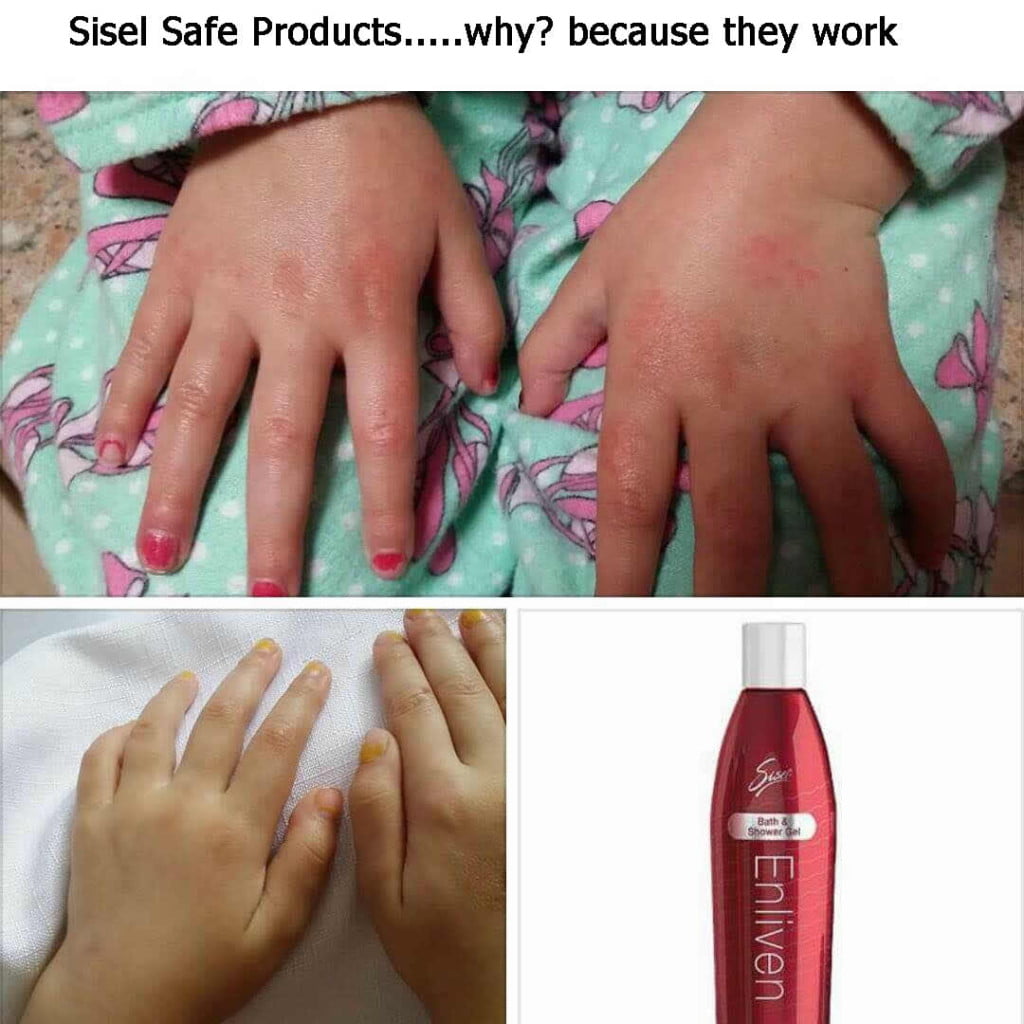
Before and After using Sisel Safe Products – Toxic Free Living -Eliven Bath and Shower Gel
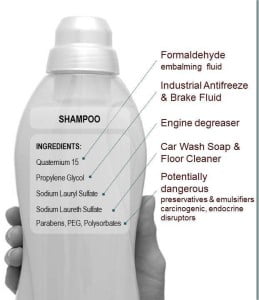
Toxic personal care Products what is in your shampoo
Sisel Safe Covert Your Bathroom plus a checklist for chemicals
Last Updated on March 27, 2023 by Katie Sisel Distributor
